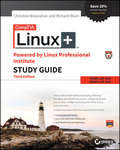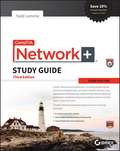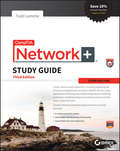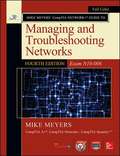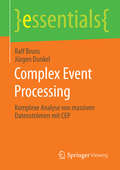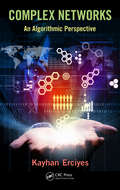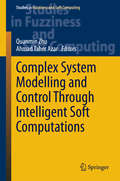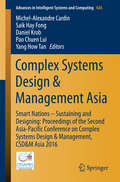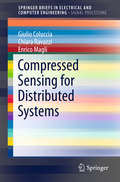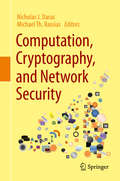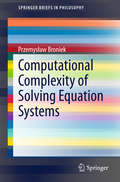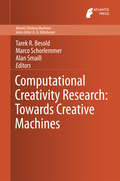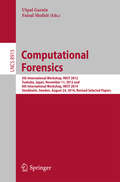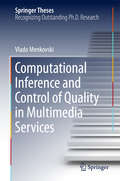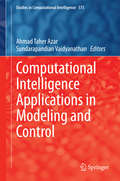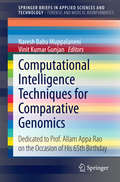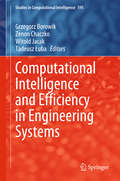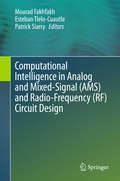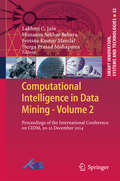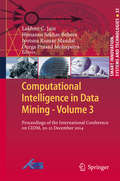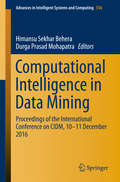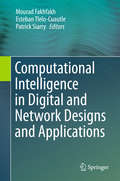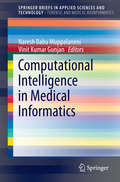- Table View
- List View
CompTIA Linux+ Powered by Linux Professional Institute Study Guide
by Richard Blum Christine BresnahanCompTIA Authorized Linux+ prepCompTIA Linux+ Study Guide is your comprehensive study guide for the Linux+ Powered by LPI certification exams. With complete coverage of 100% of the objectives on both exam LX0-103 and exam LX0-104, this study guide provides clear, concise information on all aspects of Linux administration, with a focus on the latest version of the exam. You'll gain the insight of examples drawn from real-world scenarios, with detailed guidance and authoritative coverage of key topics, including GNU and Unix commands, system operation, system administration, system services, security, and more, from a practical perspective that easily translates into on-the-job know-how. You'll also get access to helpful study tools, including bonus practice exams, electronic flashcards, and a searchable glossary of key terms that are important to know for exam day. Linux is viewed by many companies and organizations as an excellent, low-cost, secure alternative to expensive operating systems such as Microsoft Windows. The CompTIA Linux+ Powered by LPI exams test a candidate's understanding and familiarity with the Linux Kernel. Review the basic system architecture, installation, and management Understand commands, devices, and file systems Utilize shells, scripting, and data management techniques Navigate user interfaces, desktops, and essential system services As the Linux server market share continue to grow, so too does the demand for qualified and certified Linux administrators. Certification holders must recertify every five years, but LPI recommends recertifying every two years to stay fully up to date with new technologies and best practices. CompTIA Linux+ Study Guide gives you the advantage of exam day confidence.
CompTIA Network+ Study Guide
by Todd LammleAll-star N10-006 prep, fully updated for the new exam The CompTIA Network+ Study Guide is your one-stop comprehensive resource in preparing for exam N10-006. Bestselling author and networking Guru Todd Lammle guides you through 100% of all exam objectives detailing the fundamental concepts you will need to know to prepare for the exam. Coverage includes network technologies, installation and configuration, media and topologies, security, and much more, plus practical examples drawn from real-world situations.
CompTIA Network+ Study Guide: Exam N10-006
by Todd LammleCovers 100% of exam objectives, including explaining the functions and applications of various network devices, using appropriate monitoring tools, implementing network hardening techniques, troubleshooting and resolving common wireless issues, and much more...Includes interactive online learning environment and study tools with: + 2 custom practice exams + More than 100 Electronic Flashcards + Searchable key term glossary Your complete guide to preparing for CompTIA Network+ Exam N10-006 The CompTIA Network+ Study Guide, 3rd Edition is your one-stop resource for complete coverage of Exam N10-006. This Sybex Study Guide covers 100% of all exam N10-006 objectives. You'll prepare for the exam smarter and faster with Sybex thanks to superior content including, assessment tests that check exam readiness, objective map, real-world scenarios, hands-on exercises, key topic exam essentials, and challenging chapter review questions. Reinforce what you have learned with the exclusive Sybex online learning environment and test bank, accessible across multiple devices. Get prepared for the CompTIA Network+ exam with Sybex. Coverage of 100% of all exam objectives in this Study Guide means you'll be ready for: Comparing and contrasting the use of networking services and applications Installing and configuring network services/applications Analyzing metrics and reports from monitoring and tracking performance tools Using appropriate resources to support configuration management Comparing and contrasting common network vulnerabilities and threats Installing and configuring a basic firewall Summarizing basic forensic concepts Implementing network troubleshooting methodology Troubleshooting and resolving common copper cable issues Troubleshooting and resolving common network issues Analyzing and determining the correct OSI layer Explaining the basics of network theory and concepts Summarizing safety practices Installing and configuring equipment in the appropriate location using best practices Interactive learning environment Take your exam prep to the next level with Sybex's superior interactive online tools. To access the learning environment, simply visit: http://sybextestbanks.wiley.com, type in your unique PIN and instantly gain access to: Interactive test bank with 2 practice exams. Practice exams help you identify areas where further review is needed. Get more than 90% of the answers correct, and you're ready to take the certification exam. 100 questions total! More than 100 Electronic Flashcards to reinforce learning and provide lastminute prep before the exam Comprehensive glossary in PDF format that gives you instant access to the key terms so you are fully prepared
CompTIA Network+® Guide to Managing and Troubleshooting Networks, Fourth Edition
by Mike MeyersEssential Skills for a Successful IT Career Written by Mike Meyers, the leading expert on CompTIA certification and training, this up-to-date, full-color text will prepare you for CompTIA Network+ exam N10-006 and help you become an expert networking technician. Fully revised for the latest CompTIA Network+ exam, including coverage of performance-based questions, the book contains helpful on-the-job tips, end-of-chapter practice questions, and hundreds of photographs and illustrations. Mike Meyers' CompTIA Network+ Guide to Managing and Troubleshooting Networks, Fourth Edition covers: Network architectures Cabling and topology Ethernet basics Network installation TCP/IP applications and network protocols Routing Network naming Advanced networking devices IPv6 Remote connectivity Wireless networking Virtualization and cloud computing Network operations Managing risk Network security Network monitoring and troubleshooting Electronic content includes: 100+ practice exam questions in a customizable test engine 20+ lab simulations to help you prepare for the performance-based questions One hour of video training from Mike Meyers Mike's favorite shareware and freeware networking tools and utilities PDF copy of the book Each chapter features: Learning objectives Photographs and illustrations Real-world examples Try This! and Cross Check exercises Key terms highlighted Tech Tips, Notes, and Warnings Exam Tips End-of-chapter quizzes and lab projects Instructor resources available: Instructor's Manual Power Point slides for each chapter with photographs and illustrations from the book Test Bank cartridges with hundreds of questions for use as quizzes and exams Answers to the end of chapter sections are not printed in the book and are only available to adopting instructors
Complete Photography: Understand cameras to take, edit and share better photos
by Chris GatcumWhether you're a complete beginner, a casual snapper or a seasoned photographer, there is a lot to be learned from this extensive photography guide. Take the guesswork out of your photography and understand not just what to do with your camera, but how and why this affects the photos you take. You'll learn how to compose a shot for visual impact, focus it to attract the viewer's eye, expose it so every detail is captured and so much more. Photography never stands still so it doesn't matter what camera you have, whether you own an SLR, film camera or a compact digital camera, Gatcum will teach you how to take the best photos possible. As well as Gatcum's own expertise on the subject, Complete Photography is packed with tips and masterclasses from other inspirational professionals.
Complete Photography: Understand cameras to take, edit and share better photos
by Chris GatcumWhether you're a complete beginner, a casual snapper or a seasoned photographer, there is a lot to be learned from this extensive photography guide. Take the guesswork out of your photography and understand not just what to do with your camera, but how and why this affects the photos you take. You'll learn how to compose a shot for visual impact, focus it to attract the viewer's eye, expose it so every detail is captured and so much more. Photography never stands still so it doesn't matter what camera you have, whether you own an SLR, film camera or a compact digital camera, Gatcum will teach you how to take the best photos possible. As well as Gatcum's own expertise on the subject, Complete Photography is packed with tips and masterclasses from other inspirational professionals.
Complex Event Processing: Komplexe Analyse von massiven Datenströmen mit CEP (essentials)
by Ralf Bruns Jürgen DunkelRalf Bruns und Jürgen Dunkel bieten eine kompakte Einführung in die Grundprinzipien von Complex Event Processing (CEP), das eine extrem leistungsfähige Softwaretechnologie zur systematischen Analyse von massiven Datenströmen in Echtzeit darstellt. Die Autoren stellen die wesentlichen Sprachkonzepte der Ereignisverarbeitung Schritt für Schritt vor. Eine Fallstudie aus dem M2M-Bereich verdeutlicht die praktische Anwendung von CEP. Moderne Unternehmen stehen vor der Herausforderung mit immer größeren Datenmengen umgehen zu müssen. Neben immensen statischen Datenbeständen ist es entscheidend, auch kontinuierlich eintreffende Datenströme effizient zu nutzen, um geschäftliche Entscheidungen situationsabhängig treffen zu können. Mit CEP ist es möglich, hochfrequente Datenströme intelligent zu analysieren und daraus zeitnah operative Unternehmensentscheidungen abzuleiten. CEP steht für eine neue Qualität von Unternehmensanwendungen - agil und effizient.
Complex Networks: An Algorithmic Perspective
by Kayhan ErciyesComplex Networks: An Algorithmic Perspective supplies the basic theoretical algorithmic and graph theoretic knowledge needed by every researcher and student of complex networks. This book is about specifying, classifying, designing, and implementing mostly sequential and also parallel and distributed algorithms that can be used to analyze the static properties of complex networks. Providing a focused scope which consists of graph theory and algorithms for complex networks, the book identifies and describes a repertoire of algorithms that may be useful for any complex network.
Complex System Modelling and Control Through Intelligent Soft Computations (Studies in Fuzziness and Soft Computing #319)
by Ahmad Taher Azar Quanmin ZhuThe book offers a snapshot of the theories and applications of soft computing in the area of complex systems modeling and control. It presents the most important findings discussed during the 5th International Conference on Modelling, Identification and Control, held in Cairo, from August 31-September 2, 2013. The book consists of twenty-nine selected contributions, which have been thoroughly reviewed and extended before their inclusion in the volume. The different chapters, written by active researchers in the field, report on both current theories and important applications of soft-computing. Besides providing the readers with soft-computing fundamentals, and soft-computing based inductive methodologies/algorithms, the book also discusses key industrial soft-computing applications, as well as multidisciplinary solutions developed for a variety of purposes, like windup control, waste management, security issues, biomedical applications and many others. It is a perfect reference guide for graduate students, researchers and practitioners in the area of soft computing, systems modeling and control.
Complex Systems Design & Management Asia: Smart Nations – Sustaining and Designing: Proceedings of the Second Asia-Pacific Conference on Complex Systems Design & Management, CSD&M Asia 2016 (Advances in Intelligent Systems and Computing #426)
by Michel-Alexandre Cardin Saik Hay Fong Daniel Krob Pao Chuen Lui Yang How TanThis book contains all refereed papers that were accepted to the first edition of the Asia-Pacific conference on « Complex Systems Design & Management » (CSD&M Asia 2014) that took place in Singapore from December 10 to December 12, 2014 (Website: http://www. 2014. csdm-asia. net/). These proceedings cover the most recent trends in the emerging field of Complex Systems, both from an academic and a professional perspective. A special focus is put on Designing Smart cities. The CSD&M Asia 2014 conference is organized under the guidance of the Center of Excellence on Systems Architecture, Management, Economy and Strategy, CESAMES, non-profit organization, address: CESAMES, 8 rue de Hanovre, 75002 Paris, France ( Website : http://www. cesames. net/en).
Compressed Sensing for Distributed Systems (SpringerBriefs in Electrical and Computer Engineering)
by Giulio Coluccia Chiara Ravazzi Enrico MagliThis book presents a survey of the state-of-the art in the exciting and timely topic of compressed sensing for distributed systems. It has to be noted that, while compressed sensing has been studied for some time now, its distributed applications are relatively new. Remarkably, such applications are ideally suited to exploit all the benefits that compressed sensing can provide. The objective of this book is to provide the reader with a comprehensive survey of this topic, from the basic concepts to different classes of centralized and distributed reconstruction algorithms, as well as a comparison of these techniques. This book collects different contributions on these aspects. It presents the underlying theory in a complete and unified way for the first time, presenting various signal models and their use cases. It contains a theoretical part collecting latest results in rate-distortion analysis of distributed compressed sensing, as well as practical implementations of algorithms obtaining performance close to the theoretical bounds. It presents and discusses various distributed reconstruction algorithms, summarizing the theoretical reconstruction guarantees and providing a comparative analysis of their performance and complexity. In summary, this book will allow the reader to get started in the field of distributed compressed sensing from theory to practice. We believe that this book can find a broad audience among researchers, scientists, or engineers with very diverse backgrounds, having interests in mathematical optimization, network systems, graph theoretical methods, linear systems, stochastic systems, and randomized algorithms. To help the reader become familiar with the theory and algorithms presented, accompanying software is made available on the authors' web site, implementing several of the algorithms described in the book. The only background required of the reader is a good knowledge of advanced calculus and linear algebra.
Computation, Cryptography, and Network Security
by Nicholas J. Daras Michael Th. RassiasAnalysis, assessment, and data management are core competencies for operation research analysts. This volume addresses a number of issues and developed methods for improving those skills. It is an outgrowth of a conference held in April 2013 at the Hellenic Military Academy, and brings together a broad variety of mathematical methods and theories with several applications. It discusses directions and pursuits of scientists that pertain to engineering sciences. It is also presents the theoretical background required for algorithms and techniques applied to a large variety of concrete problems. A number of open questions as well as new future areas are also highlighted. This book will appeal to operations research analysts, engineers, community decision makers, academics, the military community, practitioners sharing the current "state-of-the-art," and analysts from coalition partners. Topics covered include Operations Research, Games and Control Theory, Computational Number Theory and Information Security, Scientific Computing and Applications, Statistical Modeling and Applications, Systems of Monitoring and Spatial Analysis.
Computational Complexity of Solving Equation Systems (SpringerBriefs in Philosophy)
by Przemysław BroniekThis volume considers the computational complexity of determining whether a system of equations over a fixed algebra A has a solution. It examines in detail the two problems this leads to: SysTermSat(A) and SysPolSat(A), in which equations are built out of terms or polynomials, respectively. The book characterizes those algebras for which SysPolSat can be solved in a polynomial time. So far, studies and their outcomes have not covered algebras that generate a variety admitting type 1 in the sense of Tame Congruence Theory. Since unary algebras admit only type 1, this book focuses on these algebras to tackle the main problem. It discusses several aspects of unary algebras and proves that the Constraint Satisfaction Problem for relational structures is polynomially equivalent to SysTermSat over unary algebras. The book's final chapters discuss partial characterizations, present conclusions, and describe the problems that are still open.
Computational Creativity Research: Towards Creative Machines (Atlantis Thinking Machines #7)
by Tarek R. Besold Marco Schorlemmer Alan SmaillComputational Creativity, Concept Invention, and General Intelligence in their own right all are flourishing research disciplines producing surprising and captivating results that continuously influence and change our view on where the limits of intelligent machines lie, each day pushing the boundaries a bit further. By 2014, all three fields also have left their marks on everyday life - machine-composed music has been performed in concert halls, automated theorem provers are accepted tools in enterprises' R&D departments, and cognitive architectures are being integrated in pilot assistance systems for next generation airplanes. Still, although the corresponding aims and goals are clearly similar (as are the common methods and approaches), the developments in each of these areas have happened mostly individually within the respective community and without closer relationships to the goings-on in the other two disciplines. In order to overcome this gap and to provide a common platform for interaction and exchange between the different directions, the International Workshops on "Computational Creativity, Concept Invention, and General Intelligence" (C3GI) have been started. At ECAI-2012 and IJCAI-2013, the first and second edition of C3GI each gathered researchers from all three fields, presenting recent developments and results from their research and in dialogue and joint debates bridging the disciplinary boundaries. The chapters contained in this book are based on expanded versions of accepted contributions to the workshops and additional selected contributions by renowned researchers in the relevant fields. Individually, they give an account of the state-of-the-art in their respective area, discussing both, theoretical approaches as well as implemented systems. When taken together and looked at from an integrative perspective, the book in its totality offers a starting point for a (re)integration of Computational Creativity, Concept Invention, and General Intelligence, making visible common lines of work and theoretical underpinnings, and pointing at chances and opportunities arising from the interplay of the three fields.
Computational Forensics: 5th International Workshop, IWCF 2012, Tsukuba, Japan, November 11, 2012 and 6th International Workshop, IWCF 2014, Stockholm, Sweden, August 24, 2014, Revised Selected Papers (Lecture Notes in Computer Science #8915)
by Utpal Garain Faisal ShafaitThis book constitutes the refereed post-conference proceedings of the 5th and 6th International Workshops on Computational Forensics, IWCF 2012 and IWCF 2014, held in Tsukuba, Japan, in November 2010 and August 2014. The 16 revised full papers and 1 short paper were carefully selected from 34 submissions during a thorough review process. The papers are divided into three broad areas namely biometrics; document image inspection; and applications.
Computational Inference and Control of Quality in Multimedia Services (Springer Theses)
by Vlado MenkovskiThis thesis focuses on the problem of optimizing the quality of network multimedia services. This problem spans multiple domains, from subjective perception of multimedia quality to computer networks management. The work done in this thesis approaches the problem at different levels, developing methods for modeling the subjective perception of quality based on objectively measurable parameters of the multimedia coding process as well as the transport over computer networks. The modeling of subjective perception is motivated by work done in psychophysics, while using Machine Learning techniques to map network conditions to the human perception of video services. Furthermore, the work develops models for efficient control of multimedia systems operating in dynamic networked environments with the goal of delivering optimized Quality of Experience. Overall this thesis delivers a set of methods for monitoring and optimizing the quality of multimedia services that adapt to the dynamic environment of computer networks in which they operate.
Computational Intelligence Applications in Modeling and Control (Studies in Computational Intelligence #575)
by Ahmad Taher Azar Sundarapandian VaidyanathanThe development of computational intelligence (CI) systems was inspired by observable and imitable aspects of intelligent activity of human being and nature. The essence of the systems based on computational intelligence is to process and interpret data of various nature so that that CI is strictly connected with the increase of available data as well as capabilities of their processing, mutually supportive factors. Developed theories of computational intelligence were quickly applied in many fields of engineering, data analysis, forecasting, biomedicine and others. They are used in images and sounds processing and identifying, signals processing, multidimensional data visualization, steering of objects, analysis of lexicographic data, requesting systems in banking, diagnostic systems, expert systems and many other practical implementations. This book consists of 16 contributed chapters by subject experts who are specialized in the various topics addressed in this book. The special chapters have been brought out in the broad areas of Control Systems, Power Electronics, Computer Science, Information Technology, modeling and engineering applications. Special importance was given to chapters offering practical solutions and novel methods for the recent research problems in the main areas of this book, viz. Control Systems, Modeling, Computer Science, IT and engineering applications. This book will serve as a reference book for graduate students and researchers with a basic knowledge of control theory, computer science and soft-computing techniques. The resulting design procedures are emphasized using Matlab/Simulink software.
Computational Intelligence Techniques for Comparative Genomics: Dedicated to Prof. Allam Appa Rao on the Occasion of His 65th Birthday (SpringerBriefs in Applied Sciences and Technology)
by Vinit Kumar Gunjan Naresh Babu MuppalaneniThis Brief highlights Informatics and related techniques to Computer Science Professionals, Engineers, Medical Doctors, Bioinformatics researchers and other interdisciplinary researchers. Chapters include the Bioinformatics of Diabetes and several computational algorithms and statistical analysis approach to effectively study the disorders and possible causes along with medical applications.
Computational Intelligence and Efficiency in Engineering Systems (Studies in Computational Intelligence #595)
by Grzegorz Borowik Zenon Chaczko Witold Jacak Tadeusz ŁubaThis carefully edited and reviewed volume addresses the increasingly popular demand for seeking more clarity in the data that we are immersed in. It offers excellent examples of the intelligent ubiquitous computation, as well as recent advances in systems engineering and informatics. The content represents state-of-the-art foundations for researchers in the domain of modern computation, computer science, system engineering and networking, with many examples that are set in industrial application context. The book includes the carefully selected best contributions to APCASE 2014, the 2nd Asia-Pacific Conference on Computer Aided System Engineering, held February 10-12, 2014 in South Kuta, Bali, Indonesia. The book consists of four main parts that cover data-oriented engineering science research in a wide range of applications: computational models and knowledge discovery; communications networks and cloud computing; computer-based systems; and data-oriented and software-intensive systems.
Computational Intelligence in Analog and Mixed-Signal (AMS) and Radio-Frequency (RF) Circuit Design
by Esteban Tlelo-Cuautle Patrick Siarry Mourad FakhfakhThis book explains the application of recent advances in computational intelligence - algorithms, design methodologies, and synthesis techniques - to the design of integrated circuits and systems. It highlights new biasing and sizing approaches and optimization techniques and their application to the design of high-performance digital, VLSI, radio-frequency, and mixed-signal circuits and systems. This first of two related volumes addresses the design of analog and mixed-signal (AMS) and radio-frequency (RF) circuits, with 17 chapters grouped into parts on analog and mixed-signal applications, and radio-frequency design. It will be of interest to practitioners and researchers in computer science and electronics engineering engaged with the design of electronic circuits.
Computational Intelligence in Data Mining - Volume 1: Proceedings of the International Conference on CIDM, 20-21 December 2014 (Smart Innovation, Systems and Technologies #32)
by Lakhmi C. Jain Himansu Sekhar Behera Durga Prasad Mohapatra Jyotsna Kumar MandalThe contributed volume aims to explicate and address the difficulties and challenges for the seamless integration of two core disciplines of computer science, i. e. , computational intelligence and data mining. Data Mining aims at the automatic discovery of underlying non-trivial knowledge from datasets by applying intelligent analysis techniques. The interest in this research area has experienced a considerable growth in the last years due to two key factors: (a) knowledge hidden in organizations' databases can be exploited to improve strategic and managerial decision-making; (b) the large volume of data managed by organizations makes it impossible to carry out a manual analysis. The book addresses different methods and techniques of integration for enhancing the overall goal of data mining. The book helps to disseminate the knowledge about some innovative, active research directions in the field of data mining, machine and computational intelligence, along with some current issues and applications of related topics.
Computational Intelligence in Data Mining - Volume 3: Proceedings of the International Conference on CIDM, 20-21 December 2014 (Smart Innovation, Systems and Technologies #33)
by Lakhmi C. Jain Himansu Sekhar Behera Durga Prasad Mohapatra Jyotsna Kumar MandalThe contributed volume aims to explicate and address the difficulties and challenges for the seamless integration of two core disciplines of computer science, i. e. , computational intelligence and data mining. Data Mining aims at the automatic discovery of underlying non-trivial knowledge from datasets by applying intelligent analysis techniques. The interest in this research area has experienced a considerable growth in the last years due to two key factors: (a) knowledge hidden in organizations' databases can be exploited to improve strategic and managerial decision-making; (b) the large volume of data managed by organizations makes it impossible to carry out a manual analysis. The book addresses different methods and techniques of integration for enhancing the overall goal of data mining. The book helps to disseminate the knowledge about some innovative, active research directions in the field of data mining, machine and computational intelligence, along with some current issues and applications of related topics.
Computational Intelligence in Data Mining: Proceedings of the International Conference on CIDM, 10-11 December 2016 (Advances in Intelligent Systems and Computing #556)
by Himansu Sekhar Behera Durga Prasad MohapatraThe contributed volume aims to explicate and address the difficulties and challenges that of seamless integration of the two core disciplines of computer science, i. e. , computational intelligence and data mining. Data Mining aims at the automatic discovery of underlying non-trivial knowledge from datasets by applying intelligent analysis techniques. The interest in this research area has experienced a considerable growth in the last years due to two key factors: (a) knowledge hidden in organizations' databases can be exploited to improve strategic and managerial decision-making; (b) the large volume of data managed by organizations makes it impossible to carry out a manual analysis. The book addresses different methods and techniques of integration for enhancing the overall goal of data mining. The book helps to disseminate the knowledge about some innovative, active research directions in the field of data mining, machine and computational intelligence, along with some current issues and applications of related topics.
Computational Intelligence in Digital and Network Designs and Applications
by Esteban Tlelo-Cuautle Patrick Siarry Mourad FakhfakhThis book explains the application of recent advances in computational intelligence - algorithms, design methodologies, and synthesis techniques - to the design of integrated circuits and systems. It highlights new biasing and sizing approaches and optimization techniques and their application to the design of high-performance digital, VLSI, radio-frequency, and mixed-signal circuits and systems. This second of two related volumes addresses digital and network designs and applications, with 12 chapters grouped into parts on digital circuit design, network optimization, and applications. It will be of interest to practitioners and researchers in computer science and electronics engineering engaged with the design of electronic circuits.
Computational Intelligence in Medical Informatics (SpringerBriefs in Applied Sciences and Technology)
by Vinit Kumar Gunjan Naresh Babu MuppalaneniThis Brief highlights Informatics and related techniques to Computer Science Professionals, Engineers, Medical Doctors, Bioinformatics researchers and other interdisciplinary researchers. Chapters include the Bioinformatics of Diabetes and several computational algorithms and statistical analysis approach to effectively study the disorders and possible causes along with medical applications.
